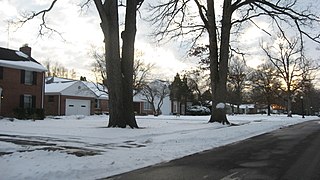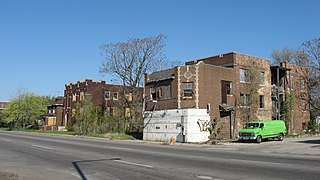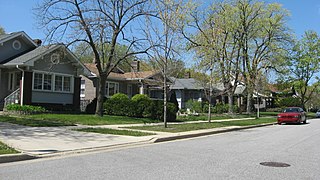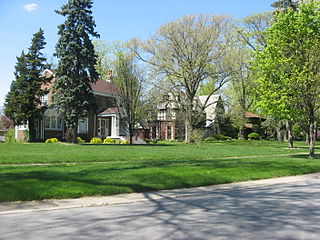
Wildwood Park Historic District is a national historic district located at Fort Wayne, Indiana. The district encompasses 190 contributing buildings, 2 contributing sites, and 1 contributing structure in a predominantly residential section of Fort Wayne. The area was developed from about 1914 to 1955, and includes notable examples of Colonial Revival, Tudor Revival, and Bungalow / American Craftsman style residential architecture. The neighborhood was platted and designed by noted landscape architect Arthur Asahel Shurcliff.

Combs Addition Historic District is a national historic district located at Gary, Indiana. The district encompasses 99 contributing buildings in an exclusively residential section of Gary. They were built between 1928 and 1959 and are examples of the American Small House cottage movement with Colonial Revival and Tudor Revival design elements.

Eskilson Historic District is a national historic district located at Gary, Indiana. The district encompasses 97 contributing buildings in an exclusively residential section of Gary. They were built during the 1920s and 1930s, and include examples of Colonial Revival, Tudor Revival, Mission Revival, and Bungalow / American Craftsman architecture.

Lincoln Street Historic District is a national historic district located at Gary, Indiana. The district encompasses 239 contributing buildings in an exclusively residential section of Gary. They were largely built between 1910 and 1950, and many reflect the American Small House Movement. Architectural styles include examples of Colonial Revival, Late Gothic Revival, Spanish Colonial Revival, and Bungalow / American Craftsman architecture.

Jefferson Street Historic District is a national historic district located at Gary, Indiana. The district encompasses 81 contributing buildings in an exclusively residential section of Gary. They were largely built between 1922 and 1945, and many reflect the American Small House Movement. Architectural styles include examples of Colonial Revival, Tudor Revival, Late Gothic Revival, Spanish Colonial Revival, and Bungalow / American Craftsman architecture.

West Fifth Avenue Apartments Historic District is a national historic district located at Gary, Indiana. The district encompasses 30 contributing buildings in a residential section of Gary. The buildings were built between 1922 and 1928, and consist of a dense group of brick apartment blocks mostly four stories tall. Architectural styles include examples of Colonial Revival, Renaissance Revival, Late Gothic Revival, and Commercial style architecture.

Forest–Moraine Residential Historic District is a national historic district located at Hammond, Lake County, Indiana. The district encompasses 108 contributing buildings in an exclusively residential section of Hammond. It developed between about 1913 and 1950, and includes notable example of Renaissance Revival, Colonial Revival, Tudor Revival, and English Cottage style residential architecture.

Forest–Southview Residential Historic District is a national historic district located at Hammond, Lake County, Indiana. The district encompasses 39 contributing buildings and 1 contributing site in an exclusively residential section of Hammond. It developed between about 1912 and 1949, and includes notable example of Renaissance Revival, Colonial Revival, Tudor Revival, and Bungalow / American Craftsman styles of residential architecture.

Glendale Park Historic District is a national historic district located at Hammond, Lake County, Indiana. The district encompasses 13 contributing buildings and 1 contributing site in an exclusively residential section of Hammond. It developed between about 1905 and 1926, and includes notable example of Colonial Revival, Tudor Revival, Prairie School and Bungalow / American Craftsman styles of residential architecture. The houses are arranged along a parkway with Glendale Park in the center.

Elston Grove Historic District is a national historic district located at Michigan City, LaPorte County, Indiana. The district encompasses 215 contributing buildings and 1 contributing structure in a predominantly residential section of Michigan City. It developed between about 1860 and 1963, and includes examples of Italianate, Greek Revival, Queen Anne, Colonial Revival, and Bungalow / American Craftsman style architecture. Notable buildings include the A.J. Henry House, Kubik Doctors Office (1953), Manny House (1902), Haskell-Boyd House, Moritz House (1911), Zorn Brewey, Petti Grocery, Luchtman Building, Dr. Ginther House (1940), Sherman Apartment Building (1921), First Baptist Church (1914), the Public Library (1896-1897), and the Adventist Church - Christian Science Church.

Plymouth Northside Historic District is a national historic district located at Plymouth, Marshall County, Indiana. The district encompasses 141 contributing buildings, 2 contributing sites, 6 contributing structures, and 3 contributing objects in a predominantly residential section of Plymouth. It developed between about 1870 and 1940, and includes examples of Italianate, Gothic Revival, Queen Anne, Colonial Revival, Tudor Revival, Neoclassical, and Renaissance Revival style architecture. Located in the district is the separately listed Marshall County Courthouse. Other notable contributing resources include Magnetic Park, First United Methodist Church (1914-1915), J.C. Capron House (1900), Samuel Schlosser House (1910-1911), Clay Metsker House (1917-1918), Plymouth Church of the Brethren (1950-1951), Logan-Stanley Fountain, Stevens House (1895), and First Presbyterian Church (1896-1897).

Plymouth Southside Historic District is a national historic district located at Plymouth, Marshall County, Indiana. The district encompasses 91 contributing buildings, 2 contributing structures, and 1 contributing object in a predominantly residential section of Plymouth. It developed between about 1853 and 1953, and includes examples of Italianate, Greek Revival, Queen Anne, Colonial Revival, and Tudor Revival style architecture. Notable contributing resources include the John McFarlin, Jr., House, Trinity United Methodist Church (1926), Bible Baptist Church (1894), Felke Florist and Greenhouse (1922), John Soice Residence, Westervelt-Marble Residence, and Edwards-Gambel Residence (1856).

Prospect Hill Historic District is a national historic district located at Bloomington, Monroe County, Indiana. The district encompasses 38 contributing buildings and 8 contributing structures in a predominantly residential section of Bloomington. It developed between about 1840 and 1936, and includes notable examples of Queen Anne, Colonial Revival, Tudor Revival, Mission Revival, and Bungalow/American Craftsman style architecture. Located in the district is the separately listed Blair-Dunning House.

Brendonwood Historic District, also known as Brendonwood Common, is a national historic district located at Indianapolis, Indiana. It encompasses 85 contributing buildings, 2 contributing sites, and 1 contributing object in a planned suburban residential section of Indianapolis. 350 acres on the eastern edge of Millersville with Fall Creek as the western boundary was the vision of Charles S. Lewis for a self-regulated residential zone of 110 plots. Noted landscape architect George E. Kessler was hired to develop the planned community. The district developed between about 1917 and 1954, and includes representative examples of Tudor Revival, Colonial Revival, and Bungalow / American Craftsman style architecture. Notable contributing resources include the Common House (1924), golf course, Two Knolls (1951-1952), Farlook (1939), Springhead (1934), Dearwald (1927), Wancroft (1940), Larkwing (1952), Grasmere (1937-1938), Wetermain (1921), Whispering Trees (1952-1953), Glen Gate (1922-1923), Witching View (1928-1929), Long Ridge (1923-1924) and Great Maple (1948).

North Meridian Street Historic District is a national historic district located at Indianapolis, Indiana. It encompasses 169 contributing buildings in a high style residential section of Indianapolis. The district developed between about 1900 and 1936, and includes representative examples of Tudor Revival, Colonial Revival, and Classical Revival style architecture. Located in the district is the separately listed William N. Thompson House. Other notable contributing resources include the Evan-Blankenbaker House (1901), Sears-Townsend House (1930), MacGill-Wemmer House, Hugh Love House (1930), Hare-Tarkington House (1911), Shea House (1922), and Brant-Weinhardt House (1932).

Emerson Avenue Addition Historic District, also known as Emerson Heights Addition and Charles M. Cross Trust Clifford Avenue Addition, is a national historic district located at Indianapolis, Indiana. It encompasses 1,000 contributing buildings and 9 contributing objects in a planned residential section of Indianapolis. The district developed between about 1910 and 1949, and includes representative examples of Tudor Revival, Colonial Revival, and Bungalow / American Craftsman style residential architecture.

Irvington Terrace Historic District is a national historic district located at Indianapolis, Indiana. It encompasses 578 contributing buildings and 9 contributing sites in a planned residential section of Indianapolis. The district developed between about 1895 and 1959, and includes representative examples of Tudor Revival, Colonial Revival, and Bungalow / American Craftsman style residential architecture.

Horace Mann Public School No. 13 is a historic school building located at Indianapolis, Indiana. It was designed by architect Edwin May (1823–1880) and built in 1873. It is a two-story, square plan, Italianate style red brick building. It has an ashlar limestone foundation and a low hipped roof with a central gabled dormer. A boiler house was added to the property in 1918.

Holy Rosary–Danish Church Historic District, also known as Fletcher Place II, is a national historic district located at Indianapolis, Indiana. The district encompasses 183 contributing buildings in a predominantly residential section located in the central business district of Indianapolis. It was developed between about 1875 and 1930, and include representative examples of Italianate, Gothic Revival, Tudor Revival, and Renaissance Revival style architecture. Located in the district is the separately listed Horace Mann Public School No. 13. Other notable buildings include the John Kring House, Trinity Danish Evangelical Lutheran Church (1872), John Wands House (1857), Henry Homburg House, Samuel Keely House, Maria Wuensch Cottage, and Holy Rosary Catholic Church (1911-1925).

Shortridge–Meridian Street Apartments Historic District is a national historic district located at Indianapolis, Indiana. The district encompasses 136 contributing buildings in a predominantly residential section of Indianapolis. It was developed between about 1900 and 1951, and includes representative examples of Colonial Revival, Classical Revival, Late Gothic Revival, Mission Revival, Renaissance Revival, Bungalow / American Craftsman, and Art Deco style architecture. Located in the district is the separately listed Shortridge High School. Other notable buildings include the Vernon Court Apartments (1928), Fronenac Apartments (1951), Biltmore Apartments (1927), Meridian Apartments (1929), New Yorker Apartments (1917), Howland Manor (1929), Powell-Evans House (1911), Harms House (1906), Dorchester Apartments (1921), and Martin Manor Apartments (1916).
























